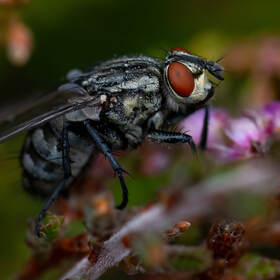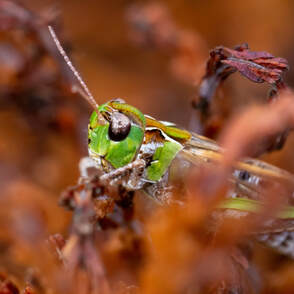Double Trouble The short answer...not particularly well. A research article published in Nature by scientists from UCL earlier this year identified that the combination of increasing temperatures and changes in land use is negatively impacting insect populations [1]. Comparing insect diversity in areas with varying degrees of agricultural intensity and climate warming, it was found that areas high in both factors had 49% fewer insects than the more natural habitats with minimal changes in temperature [1]. Additionally, these areas of intense agriculture and temperature changes had 29% fewer insect species [1]. In comparison, they found that the presence of natural habitats near land experiencing significant temperature increases but only minor agricultural intensity mitigated the loss of insects and their diversity. For example, in areas where natural habitats only comprise 25% of land cover insect abundance was reduced by 65%, whereas in similar regions containing 75% natural habitats, the reduction was only 7% [1]. Not only does this emphasise the impact of human activities on insects in regions subjected to substantial warming but it also demonstrates the importance of maintaining areas of natural habitat. Extreme Weather As climate change continues to progress, extreme weather events are becoming both more intense and more frequent. Here in the UK, we have just experienced an example of this with our (joint with 2018) hottest summer, a national drought, an all-time record temperature of 40 degrees Celsius, and the driest July on record in the south. And now following that we are experiencing heavy rain and back-to-back thunderstorms. However, we are fortunate when you look at the catastrophic flooding currently occurring in Pakistan and the 2020 Australian wildfires. But how does this relate to the world’s insect populations? The frequency of these weather events goes together with a general shift in temperature and rainfall, which ultimately has an impact on natural cycles. Studies have found that climate change has resulted in an ecological shift, demonstrated by alterations in species’ life cycles [2]. This includes species emerging from winter hibernation earlier, changes in migration timing, or reproducing earlier [2]. This can cause a variety of issues, especially if we experience a short but intense “hot spell” early in the year, which has certainly been noticeable over the last few years. For example, we might experience a few days or a week of unusually warm weather in January or February, prompting species to emerge early. Not only does this mean that they become active before their food sources are readily available but also if the warm weather does not last, they can then struggle to survive the sudden drop in temperature.
Conclusion
Given the impact climate change has on all aspects of nature, it is hardly surprising that insects are also being affected. This is not only sad but also has potentially devastating implications for humans as we depend heavily on insect activity to pollinate our crops. However, research continues to show that whilst climate change is certainly having a noticeable impact, agricultural intensity, and changes in land use by human activities are potentially a more serious threat to insect populations. As the world continues to develop, it is difficult to slow down the tide of habitat destruction. However, I think the results of the first study mentioned, whilst on the one hand quite daunting, also provide an element of hope. The substantial buffering effect of maintaining natural habitats around areas of agricultural land provides the possibility of us preventing insect populations from being a casualty of human activities. Ultimately, this information emphasises that we need to maintain areas of natural habitat, especially in regions where the human impact on the land is greatest. We need to slow the progression of climate change and reduce our overall impact; however, this is a somewhat painstakingly gradual process. Therefore, rewilding as much as we can and crucially ensuring that agricultural and developed land still has pockets of natural habitats is essential for protecting our insect populations. If not for their own sake, then for ours. Thank you for reading, as always I appreciate any and all feedback. Don't forget to find and follow me on social media: Instagram - @maw_science Twitter - @Maw_Science If you would like to learn more about rewilding and how to do it in your own garden, then head over to your favourite podcast app and listen to episode one of my new podcast 'The Birdy Bug Pod'. Run by myself and my Dad, we are chatting about nature, the environment, and what we can do to help it. I also used this insect-focused article as an excuse to use some of my macro photography, if you'd like to see more of my images then I have an Instagram account dedicate to just that (@a.bug.in.the.lens) References [1] Outhwaite, C.L., McCann, P. and Newbold, T., 2022. Agriculture and climate change are reshaping insect biodiversity worldwide. Nature, 605 (7908), pp.97-102. [2] Wilson, R.J., Davies, Z.G. and Thomas, C.D., 2007, January. Insects and climate change: processes, patterns and implications for conservation. In Insect Conservation Biology. Proceedings of the Royal Entomological Society’s 22nd Symposium. CAB International Publishing (pp. 245-279). [3] Hickling, R., Roy, D.B., Hill, J.K., Fox, R. and Thomas, C.D., 2006. The distributions of a wide range of taxonomic groups are expanding polewards. Global change biology, 12 (3), pp.450-455.
2 Comments
|
AuthorMatthew Woodard: Photographer, coffee addict, whisky lover, book worm. Archives
April 2023
Categories |
Quick Links |
© COPYRIGHT MAWSCIENCE 2023
|



 RSS Feed
RSS Feed
